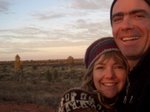
We approached the National Park with much anticipation, we had been hearing tales of this glacier from as far back in our travels as Poland.
Not knowing what to expect, and having never even seen an iceberg before, we were so excited when we spotted a lone one on the way that we had a picnic in front of it! This chunk of ice had floated about 50km from the face of the glacier.
Nothing could have prepared us for seeing the glacier. We entered the Park at about 8pm, just as everyone else was leaving. After an amazing ride through arctic forests and alongside iceblue lakes, we rounded another corner and saw it for ourselves.
The glacier decends from the vast Patagonian icefield and marches inexorably into the lake, along a 5km front. The mountains in the background of these photos are around 14km away, though it is impossible to glean the size from the photos. At the face, the ice reaches about 60m and 120m below the surface of the lake.

The glacier advances as much as 2m per day. We spent the evening with a few others who were staying the night right in front, watching (sometimes huge) slabs of ice calve off the front into the lake. The glacier creaks and sometimes bellows violently as it shifts forward and pressure in the ice is released. It is not silent for a moment.

For an idea of scale, check out the top photo again. That's a boat built for about 70 passengers on the right hand side! Many of these icebergs in the foreground are as big as houses.

We found ourselves a campsite shortly before sunset (shortly before midnight) -

 a place to ourselves on the headland, and all night we listened to the glacier creak and groan. It was an incredible night.
a place to ourselves on the headland, and all night we listened to the glacier creak and groan. It was an incredible night.
We woke shortly before the sun, and were treated to a stunning sunrise
 from our magnificent campsite.
from our magnificent campsite.

 Later, we headed around the point to find yet another track and wandered along it for a different perspective
Later, we headed around the point to find yet another track and wandered along it for a different perspective
 and for a cliff-side picnic.
and for a cliff-side picnic.

After a siesta, we had a chat with the ranger who asked us go back to the main road, and as we walked out together, we were treated to another huge chunk of ice sliding into the lake, and the aftershocks as the waves heaved and crashed into other parts of the ice. The calving icebergs cause small but strong tsunamis throughout the lake.


We left the park feeling somehow fuller. This little glacier - as it is compared to other ones - had given us a lesson in the power of the planet we live on. We had also had an insight into the timeframes that geology moves in.
 Glaciers move a lot of rock relatively quickly, grinding it to powder along the way, though the little human being barely lives long enough to realise this. And glaciers are made up of snowflakes.
Glaciers move a lot of rock relatively quickly, grinding it to powder along the way, though the little human being barely lives long enough to realise this. And glaciers are made up of snowflakes.






 We found ourselves a campsite shortly before sunset (shortly before midnight) -
We found ourselves a campsite shortly before sunset (shortly before midnight) -
































































No comments:
Post a Comment